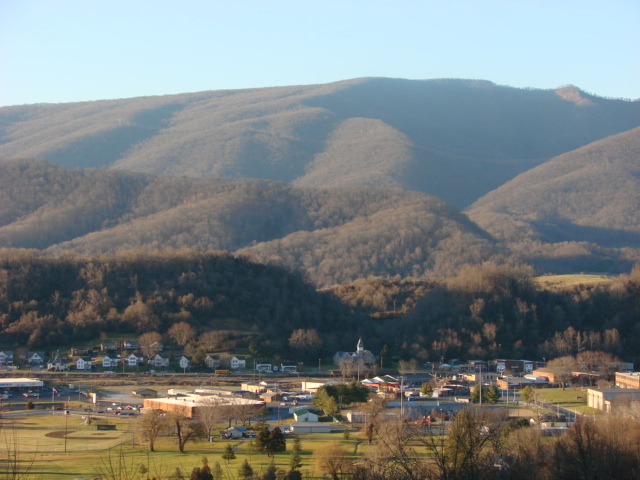A dense forest of white pine, spruce, fir, and oak grew in the Saltville River Valley 17,000 years ago. There were also some alder swamps and wet sedge meadows, but unlike in the regions to the south and west of this locality, there were no prairies or open woodlands. The Saltville River Valley is located in southwestern Virginia and during the last Ice Age, this area was much colder than the region located immediately to the south. The oceanic Gulf Stream that carries tropically-warmed water north as far as the Canadian coast today, instead only went as far north as the Virginia/North Carolina border during the Ice Age. This meant dry land temperatures in what is now Virginia were as much as 10-15 degrees Fahrenheight cooler on average than those about 50 miles further south. Consequently, the environment in the middle Atlantic States decisively differed from most of southeastern North America.

Location of the Saltville River Valley.

Saltville, Virginia is located in a beautiful valley. A large lake, known as Lake Totten, covered much of the valley from ~13,500 BP-~8,500 BP. Salt mining operations have upset the hydrology here, and today as much as 20% of the valley is underwater.
The Ice Age began waning about 15,500 years ago. The Laurentide Glacier slowly receded, and the melting ice increased the flow of water into the Saltville River. Sediment carried by the increased flow formed a mud dam in the Saltville Valley gap, causing the water to backflow and create Lake Totten. The outflow was captured by another river. Many of the species of large mammals that lived in North America then were attracted to the abundant salt springs in the area. The individuals that happened to die during periods of increased sediment flow were buried by mud and preserved for fossil enthusiasts and scientists to find thousands of years later.
An assortment of fossils found at Saltville. The animals were buried by mud carried by river surges resulting from melting glacial ice to the north. Paleontologists have to pump out groundwater from their excavation sites here. Salt mining operations have caused much of the land to flood.
The Saltville fossil site is the most southerly known location where specimens of woolly mammoth (Mammuthus primigenius) have been excavated. Specimens of Columbian mammoth (Mammuthus columbi) have been excavated here too, showing the 2 species co-existed in some locations. The 2 species of mammoth have also been found together at a site in South Dakota. Columbian mammoths ranged much farther south than woolies, having occupied territory as far south as what today is Florida. Other megafauna species recovered at Saltville include mastodon, Jefferson’s ground sloth, woodland musk-ox, bison, stag-moose (Cervalces scotti), caribou, white tail deer, horse, and giant short-faced bear (Arctodus simus). Scientists have yet to publish their findings on the smaller species of animals discovered in the fossil deposits.

Puncture mark on a mammoth heal bone made by a giant short-faced bear’s canine.

Gnaw marks on an ankle bone, probably made by a dire wolf.
A mammoth heel bone excavated from this site has a puncture mark that matches the canine of a giant short-faced bear. This species of bruin is thought to have specialized in kleptoscavenging. (See: https://markgelbart.wordpress.com/2012/12/10/bearzilla-the-biggest-bear-in-history/) The ankle bone of the same animal was gnawed on by a canid, probably a dire wolf.
A study of the bone chemistry of fossil herbivores from this site had an unexpected result. All the herbivores living in this region then ate C-3 (carbon 3) vegetation–trees, shrubs, and some herbs. Even species such as mammoths, bison, and horses that predominately subsisted on C-4 vegetation (grass) elsewhere were restricted to a diet of twigs, leaves, bark, and herbs here. This is considered evidence that prairies were absent from this particular region during this time period. The authors of this study admit their findings weren’t sufficient evidence to make any conclusions about megafauna extinctions. Yet, they suggested competition between grazers and browsers for the same resources may have caused megafaunal extinctions. I disagree with this conjecture. Instead, I think their findings are strong evidence against climate change as a cause of megafaunal extinctions because the study shows these animals were not picky eaters and could adapt well to changing environmental conditions.
Humans apparently killed, butchered, cooked, and ate a mastodon at Saltville 17,000 years ago. Archaeologists found cut marks on a mastodon’s bones as well as congealed grease that could only be the result of cooking. They also found heat-cracked rocks used in the cooking process. Pre-Clovis artifacts found associated with the mastodon bones include 2 sandstone knives, a chert blade made out of rock transported from some distance away, and flakes (debitage) from tool-making. The site was occupied 3 times prior to the Clovis era. The most recent pre-Clovis horizon dates to about 15,000 years ago and includes a midden containing hundreds of shells from giant floater clams. This species of freshwater mussel grows to 10 inches long and used to be abundant in North American waters before modern day pollution and river damming.

Giant floater clam (Pyganodon grandis). I’ve never eaten a freshwater mussel, but they smell like delicious oysters.
Saltville is not a new site. Thomas Jefferson knew about fossils found here. Scientists have been excavating fossils off and on here for over 200 years. A team from East Tennessee State completed the most recent excavation this year. They visited local amateur fossil collectors to examine their specimens, and they are surveying caves in the nearby mountains in the hopes of finding more fossils to help piece together the regional late Pleistocene ecology. We haven’t heard the last about this site.
References:
France, Christine; et. al.
“Carbon and Nitrogen Isotopic Analysis of Pleistocene Mammals from the Saltville Quarry (Virginia USA): Implications for Trophic Relationships”
Paleogeography, Paleoclimatology, Paleoecology 249 2007
Schubert, Blaine; and Steven Wallace
“Late Pleistocene Giant Short-Faced Bears, Mammoths, and Large Carcass Scavenging in the Saltville Valley of Virginia, USA”
Boreas 38 (3) August 2009